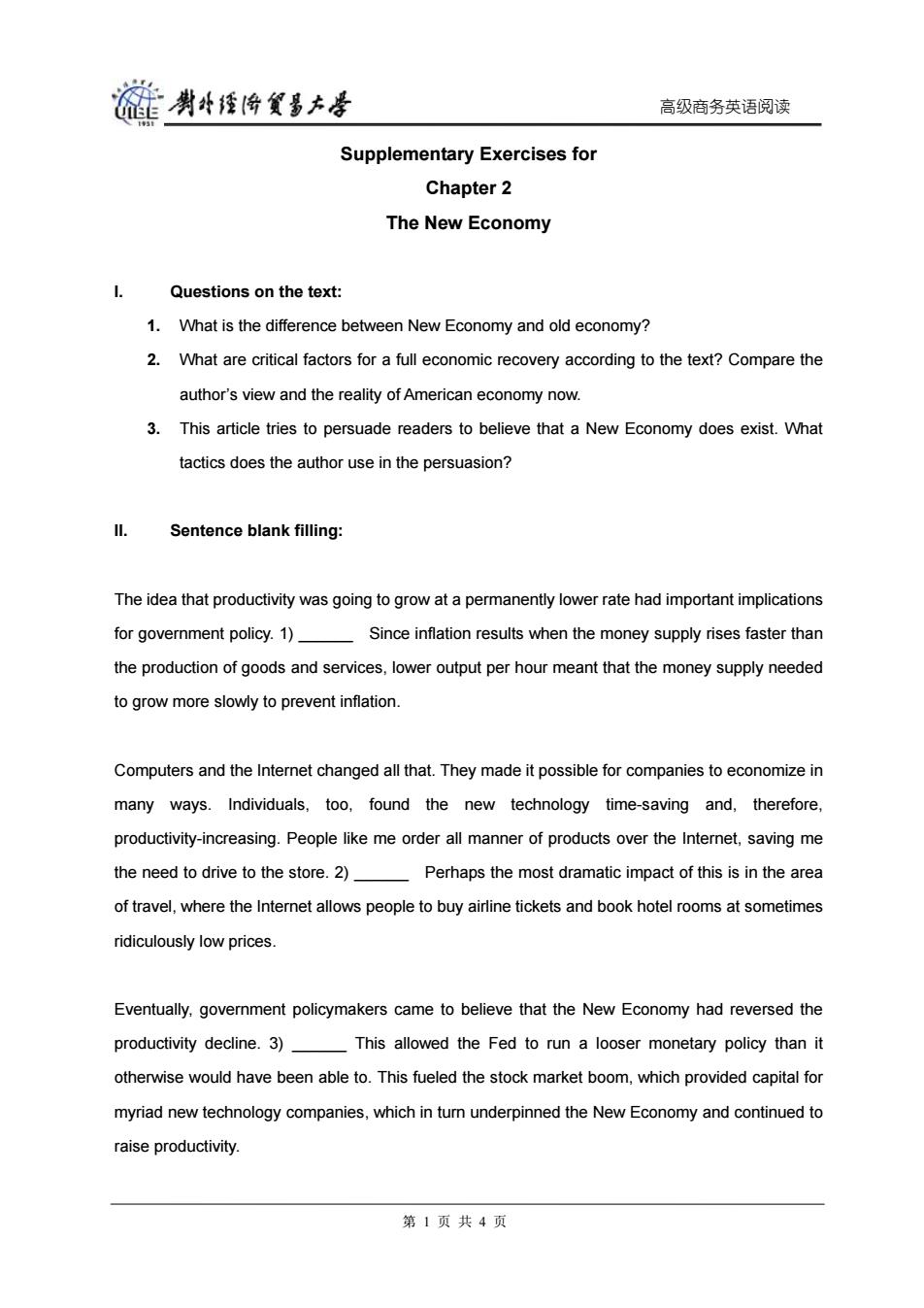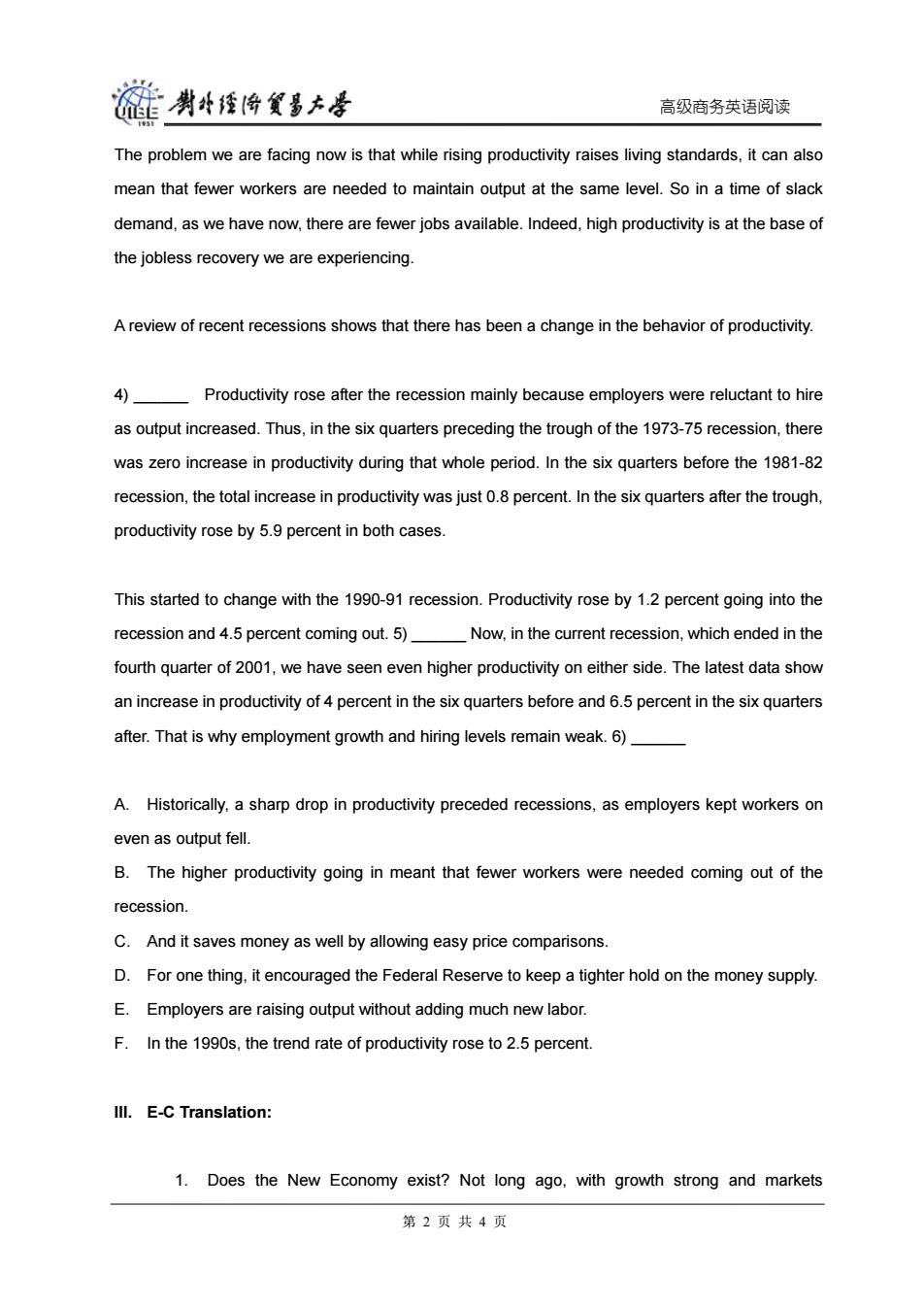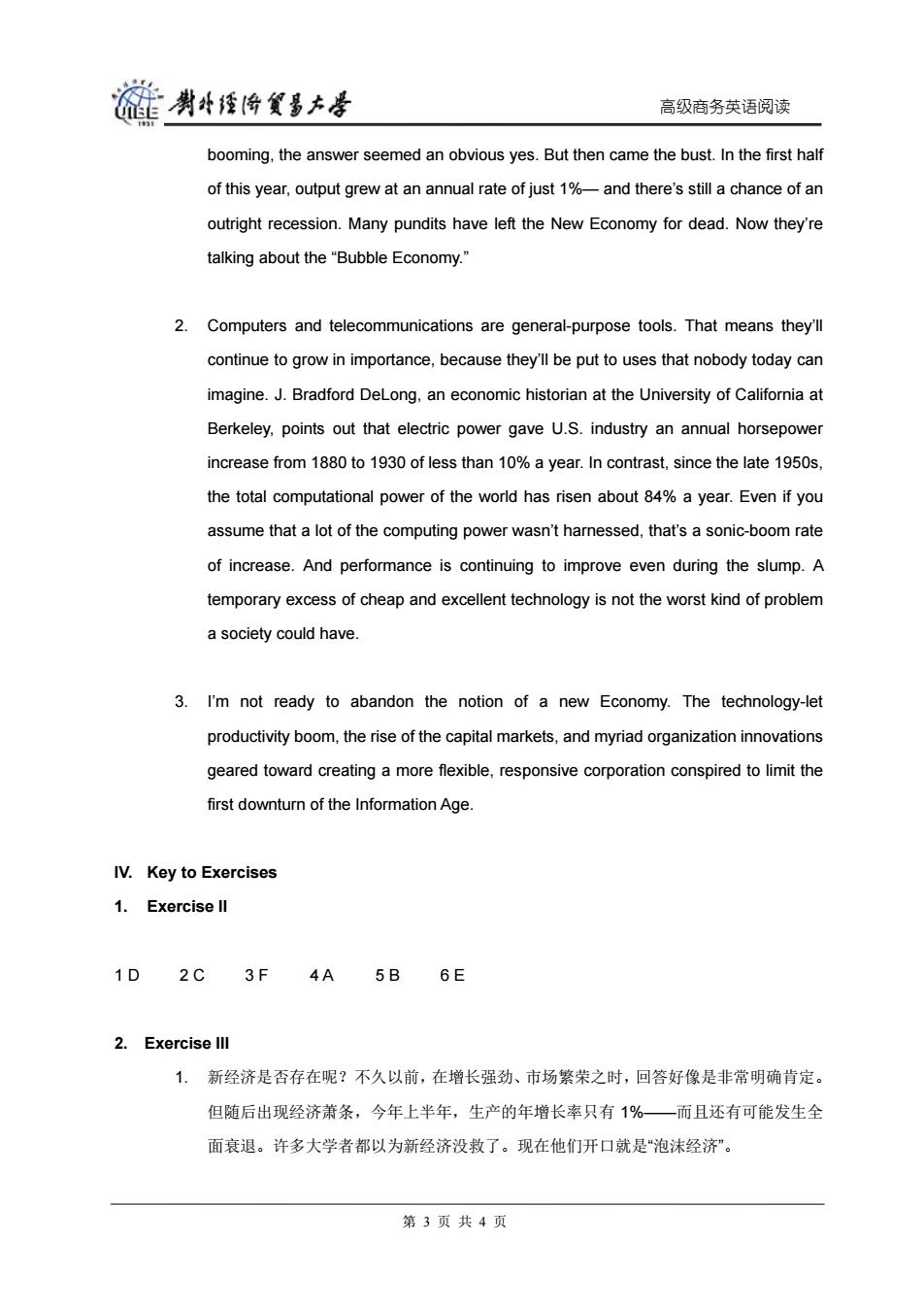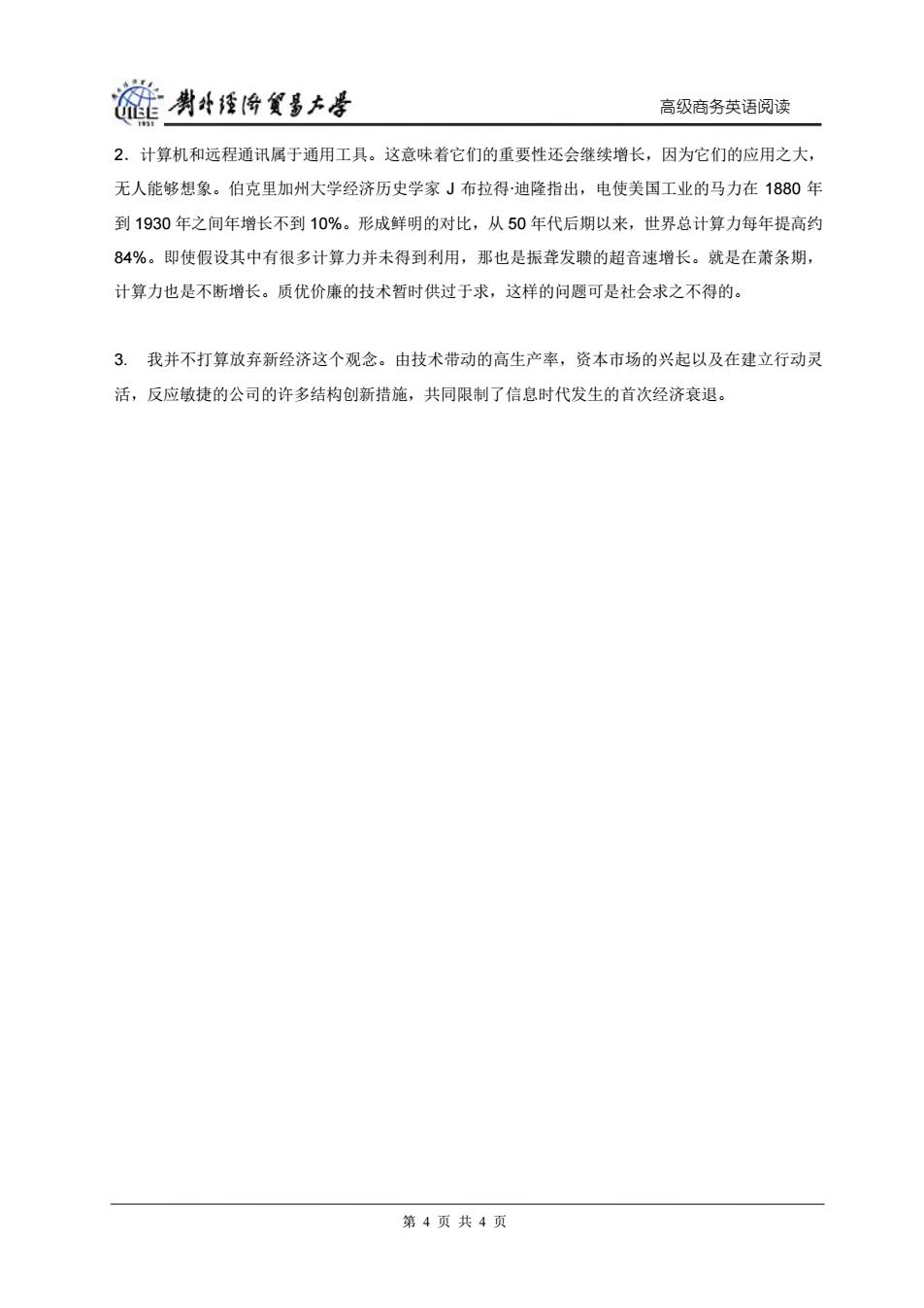
莲喇母透降贸多大号 高级商务英语阅读 Supplementary Exercises for Chapter 2 The New Economy 1. Questions on the text: 1.What is the difference between New Economy and old economy? 2.What are critical factors for a full economic recovery according to the text?Compare the author's view and the reality of American economy now. 3. This article tries to persuade readers to believe that a New Economy does exist.What tactics does the author use in the persuasion? Sentence blank filling: The idea that productivity was going to grow at a permanently lower rate had important implications for government policy.1)Since inflation results when the money supply rises faster than the production of goods and services,lower output per hour meant that the money supply needed to grow more slowly to prevent inflation. Computers and the Internet changed all that.They made it possible for companies to economize in many ways.Individuals,too,found the new technology time-saving and,therefore, productivity-increasing.People like me order all manner of products over the Internet,saving me the need to drive to the store.2)Perhaps the most dramatic impact of this is in the area of travel,where the Internet allows people to buy airline tickets and book hotel rooms at sometimes ridiculously low prices. Eventually,government policymakers came to believe that the New Economy had reversed the productivity decline.3)This allowed the Fed to run a looser monetary policy than it otherwise would have been able to.This fueled the stock market boom,which provided capital for myriad new technology companies,which in turn underpinned the New Economy and continued to raise productivity. 第1页共4页
高级商务英语阅读 Supplementary Exercises for Chapter 2 The New Economy I. Questions on the text: 1. What is the difference between New Economy and old economy? 2. What are critical factors for a full economic recovery according to the text? Compare the author’s view and the reality of American economy now. 3. This article tries to persuade readers to believe that a New Economy does exist. What tactics does the author use in the persuasion? II. Sentence blank filling: The idea that productivity was going to grow at a permanently lower rate had important implications for government policy. 1) ______ Since inflation results when the money supply rises faster than the production of goods and services, lower output per hour meant that the money supply needed to grow more slowly to prevent inflation. Computers and the Internet changed all that. They made it possible for companies to economize in many ways. Individuals, too, found the new technology time-saving and, therefore, productivity-increasing. People like me order all manner of products over the Internet, saving me the need to drive to the store. 2) ______ Perhaps the most dramatic impact of this is in the area of travel, where the Internet allows people to buy airline tickets and book hotel rooms at sometimes ridiculously low prices. Eventually, government policymakers came to believe that the New Economy had reversed the productivity decline. 3) ______ This allowed the Fed to run a looser monetary policy than it otherwise would have been able to. This fueled the stock market boom, which provided capital for myriad new technology companies, which in turn underpinned the New Economy and continued to raise productivity. 第 1 页 共 4 页

碰剥经悔贸昌大号 高级商务英语阅读 The problem we are facing now is that while rising productivity raises living standards,it can also mean that fewer workers are needed to maintain output at the same level.So in a time of slack demand,as we have now,there are fewer jobs available.Indeed,high productivity is at the base of the jobless recovery we are experiencing. A review of recent recessions shows that there has been a change in the behavior of productivity 4) Productivity rose after the recession mainly because employers were reluctant to hire as output increased.Thus,in the six quarters preceding the trough of the 1973-75 recession,there was zero increase in productivity during that whole period.In the six quarters before the 1981-82 recession,the total increase in productivity was just 0.8 percent.In the six quarters after the trough, productivity rose by 5.9 percent in both cases This started to change with the 1990-91 recession.Productivity rose by 1.2 percent going into the recession and 4.5 percent coming out.5)_Now,in the current recession,which ended in the fourth quarter of 2001,we have seen even higher productivity on either side.The latest data show an increase in productivity of 4 percent in the six quarters before and 6.5 percent in the six quarters after.That is why employment growth and hiring levels remain weak.6) A.Historically,a sharp drop in productivity preceded recessions,as employers kept workers on even as output fell. B.The higher productivity going in meant that fewer workers were needed coming out of the recession. C.And it saves money as well by allowing easy price comparisons. D.For one thing,it encouraged the Federal Reserve to keep a tighter hold on the money supply. E.Employers are raising output without adding much new labor. F.In the 1990s,the trend rate of productivity rose to 2.5 percent. Ill.E-C Translation: 1.Does the New Economy exist?Not long ago,with growth strong and markets 第2页共4页
高级商务英语阅读 The problem we are facing now is that while rising productivity raises living standards, it can also mean that fewer workers are needed to maintain output at the same level. So in a time of slack demand, as we have now, there are fewer jobs available. Indeed, high productivity is at the base of the jobless recovery we are experiencing. A review of recent recessions shows that there has been a change in the behavior of productivity. 4) ______ Productivity rose after the recession mainly because employers were reluctant to hire as output increased. Thus, in the six quarters preceding the trough of the 1973-75 recession, there was zero increase in productivity during that whole period. In the six quarters before the 1981-82 recession, the total increase in productivity was just 0.8 percent. In the six quarters after the trough, productivity rose by 5.9 percent in both cases. This started to change with the 1990-91 recession. Productivity rose by 1.2 percent going into the recession and 4.5 percent coming out. 5) ______ Now, in the current recession, which ended in the fourth quarter of 2001, we have seen even higher productivity on either side. The latest data show an increase in productivity of 4 percent in the six quarters before and 6.5 percent in the six quarters after. That is why employment growth and hiring levels remain weak. 6) ______ A. Historically, a sharp drop in productivity preceded recessions, as employers kept workers on even as output fell. B. The higher productivity going in meant that fewer workers were needed coming out of the recession. C. And it saves money as well by allowing easy price comparisons. D. For one thing, it encouraged the Federal Reserve to keep a tighter hold on the money supply. E. Employers are raising output without adding much new labor. F. In the 1990s, the trend rate of productivity rose to 2.5 percent. III. E-C Translation: 1. Does the New Economy exist? Not long ago, with growth strong and markets 第 2 页 共 4 页

链勇4桂降食多大量 高级商务英语阅读 booming,the answer seemed an obvious yes.But then came the bust.In the first half of this year,output grew at an annual rate of just 1%-and there's still a chance of an outright recession.Many pundits have left the New Economy for dead.Now they're talking about the "Bubble Economy." 2. Computers and telecommunications are general-purpose tools.That means they'll continue to grow in importance,because they'll be put to uses that nobody today can imagine.J.Bradford DeLong,an economic historian at the University of California at Berkeley,points out that electric power gave U.S.industry an annual horsepower increase from 1880 to 1930 of less than 10%a year.In contrast,since the late 1950s, the total computational power of the world has risen about 84%a year.Even if you assume that a lot of the computing power wasn't harnessed,that's a sonic-boom rate of increase.And performance is continuing to improve even during the slump.A temporary excess of cheap and excellent technology is not the worst kind of problem a society could have. 3.I'm not ready to abandon the notion of a new Economy.The technology-let productivity boom,the rise of the capital markets,and myriad organization innovations geared toward creating a more flexible,responsive corporation conspired to limit the first downturn of the Information Age. IV.Key to Exercises 1.Exercise ll 1D 2C 3F 4A 5B 6E 2.Exercise lll 1.新经济是否存在呢?不久以前,在增长强劲、市场繁荣之时,回答好像是非常明确肯定。 但随后出现经济萧条,今年上半年,生产的年增长率只有1%一而且还有可能发生全 面衰退。许多大学者都以为新经济没救了。现在他们开口就是“泡沫经济”。 第3页共4页
高级商务英语阅读 booming, the answer seemed an obvious yes. But then came the bust. In the first half of this year, output grew at an annual rate of just 1%— and there’s still a chance of an outright recession. Many pundits have left the New Economy for dead. Now they’re talking about the “Bubble Economy.” 2. Computers and telecommunications are general-purpose tools. That means they’ll continue to grow in importance, because they’ll be put to uses that nobody today can imagine. J. Bradford DeLong, an economic historian at the University of California at Berkeley, points out that electric power gave U.S. industry an annual horsepower increase from 1880 to 1930 of less than 10% a year. In contrast, since the late 1950s, the total computational power of the world has risen about 84% a year. Even if you assume that a lot of the computing power wasn’t harnessed, that’s a sonic-boom rate of increase. And performance is continuing to improve even during the slump. A temporary excess of cheap and excellent technology is not the worst kind of problem a society could have. 3. I’m not ready to abandon the notion of a new Economy. The technology-let productivity boom, the rise of the capital markets, and myriad organization innovations geared toward creating a more flexible, responsive corporation conspired to limit the first downturn of the Information Age. IV. Key to Exercises 1. Exercise II 1 D 2 C 3 F 4 A 5 B 6 E 2. Exercise III 1. 新经济是否存在呢?不久以前,在增长强劲、市场繁荣之时,回答好像是非常明确肯定。 但随后出现经济萧条,今年上半年,生产的年增长率只有 1%——而且还有可能发生全 面衰退。许多大学者都以为新经济没救了。现在他们开口就是“泡沫经济”。 第 3 页 共 4 页

链剥将发多大是 高级商务英语阅读 2.计算机和远程通讯属于通用工具。这意味着它们的重要性还会继续增长,因为它们的应用之大, 无人能够想象。伯克里加州大学经济历史学家J布拉得迪隆指出,电使美国工业的马力在1880年 到1930年之间年增长不到10%。形成鲜明的对比,从50年代后期以来,世界总计算力每年提高约 84%。即使假设其中有很多计算力并未得到利用,那也是振聋发聩的超音速增长。就是在萧条期, 计算力也是不断增长。质优价廉的技术暂时供过于求,这样的问题可是社会求之不得的。 3.我并不打算放弃新经济这个观念。由技术带动的高生产率,资本市场的兴起以及在建立行动灵 活,反应敏捷的公司的许多结构创新措施,共同限制了信息时代发生的首次经济衰退。 第4页共4页
高级商务英语阅读 2.计算机和远程通讯属于通用工具。这意味着它们的重要性还会继续增长,因为它们的应用之大, 无人能够想象。伯克里加州大学经济历史学家 J 布拉得·迪隆指出,电使美国工业的马力在 1880 年 到 1930 年之间年增长不到 10%。形成鲜明的对比,从 50 年代后期以来,世界总计算力每年提高约 84%。即使假设其中有很多计算力并未得到利用,那也是振聋发聩的超音速增长。就是在萧条期, 计算力也是不断增长。质优价廉的技术暂时供过于求,这样的问题可是社会求之不得的。 3. 我并不打算放弃新经济这个观念。由技术带动的高生产率,资本市场的兴起以及在建立行动灵 活,反应敏捷的公司的许多结构创新措施,共同限制了信息时代发生的首次经济衰退。 第 4 页 共 4 页